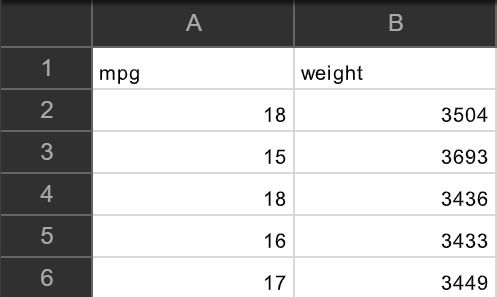Pearson Correlation Test Between Two Variables - Python
Last Updated : 17 May, 2025
Correlation is a way to measure how strongly two variables are related. In simple terms, it tells us whether two things increase or decrease together. For example:
- Do people who study more hours get higher scores?
- Does car weight affect fuel efficiency?
These questions can be answered using a correlation test.
Uses of Correlation in Data Science
- Understand relationships between two numeric values.
- Make better decisions in data analysis and machine learning.
- Select features that are useful for prediction.
- Avoid using variables that are too similar (which can cause problems).
Types of Correlation Methods
There are two main types of correlation methods:
1. Parametric Correlation
- Measures the linear dependence between two variables (e.g., x and y).
- Assumes that the data follows a normal distribution.
- Example: Pearson Correlation (most commonly used).
2. Non-Parametric Correlation
- Used when data doesn’t meet parametric assumptions.
- Based on rankings, not raw values.
- Examples: Kendall’s Tau, Spearman’s Rho
Note: The Pearson correlation method is the most widely used for linear relationships.
In this article, we will learn about Pearson Correlation:
Pearson correlation is a number that tells us how strongly two values are linearly related.
It gives a result between -1 and +1:
- +1: Perfect positive relationship (both increase together)
- -1: Perfect negative relationship (one increases, the other decreases)
- 0: No linear relationship

x, y: Two numeric vectors of the same length n
mₓ, mᵧ: Mean values of x and y respectively
Important Notes on Pearson Correlation
- Not suitable for ordinal variables.
- Requires moderate sample size (20–30) for reliable estimates.
- Sensitive to outliers, which can distort results.
Computing Pearson Correlation in Python
Python has a built-in method pearsonr() from the scipy.stats module to find the Pearson correlation.
Syntax
from scipy.stats import pearsonr
pearsonr(x, y)
Parameters:
- x, y are the numeric lists or series.
Return Type: A tuple - (correlation coefficient, p-value)
Example 1: Pearson Correlation with Car Data
In this example, we find the correlation between car weight and miles per gallon (mpg).
Here is a snapshot of the csv file used for this example:
 data.csv
data.csvTo download the above csv file used in this article, click here.
Code:
Python import pandas as pd from scipy.stats import pearsonr df = pd.read_csv("path_to_Auto.csv") # Convert dataframe into series l1 = df['weight'] l2 = df['mpg'] # Apply the pearsonr() corr, _ = pearsonr(l1, l2) print('Pearsons correlation: %.3f' % corr) Output:
Pearson correlation is: -0.878
Example 2: Anscombe’s Quartet – Same Correlation, Different Patterns
Anscombe’s Quartet is a famous example that shows why just using correlation numbers can be misleading. It has four small datasets with almost the same Pearson correlation, but very different shapes when plotted.
In this example, we will:
- Load the four datasets from a CSV file.
- Calculate the Pearson correlation for each dataset.
- Plot all datasets to see how they differ visually.
To downlod those 4 sets of 11 data-points, click here.
Python import pandas as pd import matplotlib.pyplot as plt from scipy.stats import pearsonr # Load your CSV file df = pd.read_csv("path of dataset") # Store dataset names for looping datasets = { "I": ("x1", "y1"), "II": ("x2", "y2"), "III": ("x3", "y3"), "IV": ("x4", "y4") } # Loop through each dataset and calculate Pearson correlation for name, (x_col, y_col) in datasets.items(): x = df[x_col] y = df[y_col] corr, _ = pearsonr(x, y) print(f"Dataset {name}: Pearson correlation = {corr:.3f}") # Plot each dataset in a grid fig, axs = plt.subplots(2, 2, figsize=(10, 8)) fig.suptitle('Anscombe-like Quartet Plots', fontsize=16) for i, (name, (x_col, y_col)) in enumerate(datasets.items()): row = i // 2 col = i % 2 axs[row, col].scatter(df[x_col], df[y_col]) axs[row, col].set_title(f"Dataset {name}") axs[row, col].set_xlabel(x_col) axs[row, col].set_ylabel(y_col) plt.tight_layout(rect=[0, 0.03, 1, 0.95]) plt.show() Terminal Output:
Dataset I: Pearson correlation = 0.816
Dataset II: Pearson correlation = 0.816
Dataset III: Pearson correlation = 0.816
Dataset IV: Pearson correlation = 0.817
Here we can see that the correlation is same for all the datasets but let's take a look at their correlation graphs:
Graph Output:
 Snapshot of the Plots
Snapshot of the PlotsWe can clearly see that the visual representation of them is very different, this shows why it's important to look at your data visually, not just rely on correlation values.
To know more about correlation please refer: Covariance and Correlation.